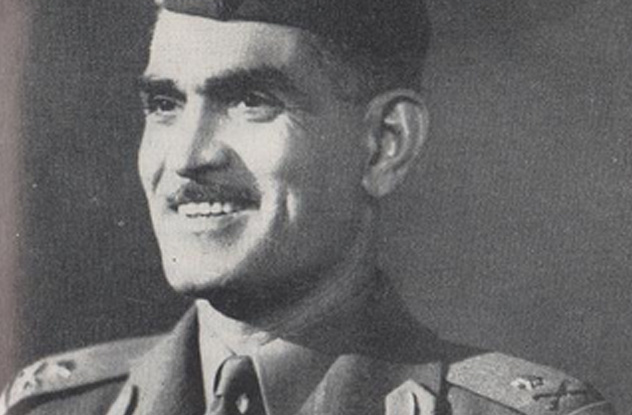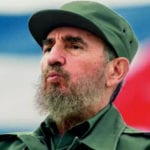 Music
Music  Music
Music  History
History 10 Less Than Jolly Events That Occurred on December 25
 Weird Stuff
Weird Stuff 10 Funny Ways That Researchers Overthink Christmas
 Politics
Politics 10 Political Scandals That Sent Crowds Into the Streets
 Weird Stuff
Weird Stuff Ten Bizarre Facts About The Doge Meme
 Our World
Our World 10 Ways Your Christmas Tree Is More Lit Than You Think
 Movies and TV
Movies and TV The 10 Coolest Stars to Set Sail on The Love Boat
 History
History 10 Things You Didn’t Know About the American National Anthem
 Technology
Technology Top 10 Everyday Tech Buzzwords That Hide a Darker Past
 Humans
Humans 10 Everyday Human Behaviors That Are Actually Survival Instincts
 Music
Music 10 Surprising Origin Stories of Your Favorite Holiday Songs
 History
History 10 Less Than Jolly Events That Occurred on December 25
 Weird Stuff
Weird Stuff 10 Funny Ways That Researchers Overthink Christmas
Who's Behind Listverse?

Jamie Frater
Head Editor
Jamie founded Listverse due to an insatiable desire to share fascinating, obscure, and bizarre facts. He has been a guest speaker on numerous national radio and television stations and is a five time published author.
More About Us Politics
Politics 10 Political Scandals That Sent Crowds Into the Streets
 Weird Stuff
Weird Stuff Ten Bizarre Facts About The Doge Meme
 Our World
Our World 10 Ways Your Christmas Tree Is More Lit Than You Think
 Movies and TV
Movies and TV The 10 Coolest Stars to Set Sail on The Love Boat
 History
History 10 Things You Didn’t Know About the American National Anthem
 Technology
Technology Top 10 Everyday Tech Buzzwords That Hide a Darker Past
 Humans
Humans 10 Everyday Human Behaviors That Are Actually Survival Instincts
10 Insane Ways The CIA Bungled Covert Operations
Depending on your political allegiances, the CIA is either a group of unsung heroes doing their best to keep America’s enemies at bay or a bunch of psychopaths slowly destroying the entire world. But another side to the story suggests the agency is neither heroic nor evil but simply run by bungling idiots.
10‘The Star-Spangled Banner’

In 1953, the US and Britain were fed up with Iran. Under Prime Minister Mohammad Mosaddeq, the country was about to nationalize the oil industry, a move that would damage British interests. The decision was taken for the CIA to oust Mosaddeq in a coup and install the autocratic Shah in place. With such a sensitive operation, it was vital that the CIA keep America’s role hidden—something it failed at to a hilarious degree.
Since this was the CIA’s first coup, the agency wasn’t as organized as they would later become. The man chosen to head the operation, Kermit Roosevelt, was discreet to the point of madness. One day at a diplomatic lunch, US-funded protestors exchanged gunfire and mortar rounds with police just outside the building. While everyone else ran to the windows in panic, Roosevelt studiously pretended nothing was happening and kept calmly eating his soup.
But the real giveaway came right after Mosaddeq had been deposed. With the coup leader, General Fazlollah Zahedi, preparing to address the nation via radio, the CIA decided to preface his broadcast with some stirring patriotic music. Digging through a collection of old records, they found what appeared to be a suitable one. They stuck it on the turntable, began the broadcast, and listened in horror as “The Star-Spangled Banner” began to play.
9The Albania Failure

Under communist dictator Enver Hoxha, life in Albania was short, cruel, and violent. So when US forces decided to depose him in 1949, the CIA figured it’d be easy to turn his populace against him. All they needed to do was send in some good guys with guns, and the Albanian people would rise up against this psychopath, right?
Unfortunately, the people the CIA chose were anything but “good guys.” With an incredible lack of foresight, the agency hired former fascists and collaborators who’d helped the Nazis subjugate their homeland to lead the Albanian resistance. Among them was the minister famous for deporting Jews to gas chambers during the occupation and a collection of devout royalists who supported the return of lunatic King Zog.
Faced with the choice between a hard-line communist and a bunch of literal Nazis, the people of Albania opted for the former. The uprising was quashed when the very people it was meant to inspire turned the CIA’s men over to the secret police, a process helped along by the agency’s poor decision to put a communist spy in charge of operations.
8The ‘Secret’ Meeting

In 2011, Lebanon was looking like the Middle East’s next flash point. Hezbollah had just crashed the government, and anti-American and Israeli sentiment was running high. The CIA responded by stepping up its operations in the field, starting with its network of spies in Beirut. The agency made three big blunders. One: calling a meeting where all of its Beirut network would be present in one place. Two: making that one place a Pizza Hut. And three: giving the Pizza Hut the code name “Pizza.”
If it was meant to be a double bluff, it failed spectacularly. Hezbollah’s agents managed to connect the dots between pizza and Pizza Hut and captured nearly every member of two separate CIA spy rings. Things only got worse for the CIA when it was revealed the spies had been given traceable phones by their handlers and received insufficient training.
Although most of the agents simply disappeared, it’s almost certain they were murdered by the militant group, a tragic end to what would otherwise be an amusing story.
7The Guantanamo Deception

By now, we’re all aware that some less than savory tactics have been used at Guantanamo Bay over the years. But the trick CIA officials used to try and get terror suspect Mohamedou Ould Slahi to cooperate fell short of unsavory and went right to dull incompetence. Convinced Slahi had some information they wanted, agents tried to extract it by forging a letter from his mother.
Slahi’s mother couldn’t write. They also spelled his name wrong, making the letter as objectively convincing as one scrawled in felt tip in a different language.
Sadly, those involved didn’t respond to this humorous mix-up by sitting down to laugh about it over a cup of coffee. Instead, they brutally tortured Slahi—beating him, sexually abusing him, and subjecting him to a mock execution. And it all turned out to be pointless. It’s now thought that Slahi never had any information to hand over.
6The Wrong Man

In December 2003, the CIA pulled off a daring rendition in Macedonia. Targeting known Al-Qaeda associate Khaled El-Masri, they managed to have him stopped at the Macedonian border and spirited away to Afghanistan. Desperate for information, they then violently tortured him, including one session where he was allegedly sodomized. It was a pretty dirty business but one they swore was essential to the security of the United States.
They got the wrong Khaled El-Masri.
In their haste to rendition El-Masri, the CIA had accidentally grabbed the wrong man. The El-Masri they’d flown to Afghanistan and repeatedly tortured wasn’t an Al-Qaeda operative at all but an innocent German businessman with a similar name. Know what the CIA did when they found out their mistake? They held onto El-Masri for almost another month.
Finally, five months after he was first captured, CIA agents flew El-Masri back to Europe and dumped him by a roadside in Albania without a word of explanation. In 2015, despite a European Court of Human Rights ruling, El-Masri still hasn’t received so much as an apology.
5The CIA And Heroin

The Vietnam War is widely regarded as one of the messiest conflicts in US history. Aside from sending nearly 60,000 US citizens to their deaths, it resulted in the humiliating fall of Saigon and contributed to the rise of Pol Pot. It also had some bizarre unintended consequences, such as raising the rates of heroin addiction across the world.
Desperate to gain an edge in the conflict, the CIA turned a blind eye to the excesses of the South Vietnamese. One such excess came direct from President Nguyen Van Thieu. Along with Laos general Vang Pao, Thieu was widely known to be involved in the heroin trade. Rather than try to wean their allies off the drug or ask them to slow down operations, the CIA supplied them with a lab to make even more and choppers to get it out to their buyers. Plenty of their buyers were American GIs.
Thanks to their role in facilitating the Vietnamese heroin trade, the CIA contributed to 30,000 American troops getting hooked and a huge increase in use across the world.
4The Milan Mistake

The rendition of Egyptian cleric Osama Mustafa Hasan Nasr from Italy in 2003 may go down in history as one of the most inept operations ever devised. Under the watch of Robert Seldon Lady, the CIA’s Milan branch succeeded in snatching Nasr and transferring him out of the country for torture. Fatally, however, they also succeeded in leaving behind a trail of clues that police investigating Nasr’s disappearance couldn’t fail to uncover.
When police looked into the missing cleric, they discovered that 12 phones registered to fake names had been used in the area where Nasr was last seen, and these phones took calls from CIA headquarters in Virginia. Using geolocation, the cops pinpointed exactly in which hotels the phones’ owners had stayed. Some agents had used their secret phones to make calls to people in their personal lives.
It gets stupider. The CIA-linked accounts used to pay the phone bills had also been used to buy airline tickets. Some of the agents had insisted on using their real names with the airline so they could collect their air miles. When Italian police used this evidence to mount a raid on Robert Seldon Lady’s home, they found a stack of photos the agency had taken while following Nasr, including (presumably) a selfie of Lady posing with him in a Guantanamo cell.
As a result of his team’s bungling, Lady was forced to go on the lam. He was eventually convicted in absentia for kidnapping by an Italian court.
3The Iraq Misjudgment

Not all bungled covert operations are a succession of amusing japes. Some have darkly unforeseen consequences. Such was the case with the 1963 mission to unseat Iraqi dictator Abdel Karim Kassem.
A general who’d deposed the previous pro-Western monarchy before going mad with power, Kassem was hugely unpopular at home. The obvious action seemed to be to simply foment a rebellion and install a new, friendlier government in Kassem’s place. In February 1963, that’s exactly what the CIA did. Stirring up chaos in Iraq, they successfully deposed and killed Kassem. The major slipup came when they installed his successor. With a reckless lack of foresight, the CIA decided to take a chance on the little-known Baathist party of Saddam Hussein.
Although Saddam wasn’t leader at the time, it catapulted him within spitting distance of the reins of power. It also allowed him to conduct his first atrocity—a killing spree in which the educated classes of Iraq (supposedly aligned with Kassem) were brutally wiped out. Thanks to their toppling of one Iraqi dictator, the CIA opened themselves to half a century of trouble in the region, trouble we’re still feeling the effects of even now.
2The CIA And More Heroin

The immediate aftermath of World War II was a dangerous time in geopolitics. With half of Europe under occupation and the rest in economic free fall, the race was on to snatch as much of the continent away from the Soviets as possible. In particular, the CIA were concerned that Italy and Sicily might fall to the Communists, so they did everything in their power to stop them. This included handing bundles of cash and equipment to the Mafia.
It wasn’t just the Italian branch they cultivated. Chicago and New York gangsters were also recruited and sent to Sicily with the money and go-ahead to do whatever they wanted. What they wanted to do was traffic heroin.
With as much help from the CIA as possible, they cultivated labs and seized control of docks, setting up a global smack network that would keep cash flowing into Mafia pockets for the best part of 25 years. The CIA even helped them export their stuff and take total control of Sicily while simultaneously rendering key players untouchable by other law enforcement agencies. While it kept the Communists out, it made heroin into the booming business it remains today.
1Giving Iran The Bomb

Although it’s only hit the headlines in the last couple of years, the Iranian nuclear program has been worrying governments for well over a decade. In 2000, the CIA became convinced Tehran was going for the bomb and that it was imperative to stop them. They decided the best way of doing that was by giving them blueprints for a working nuke.
The plan was to send the blueprints over with a Russian defector posing as a broke nuclear scientist desperate for money. He’d sell them to the Iranians at a conference in Vienna. Tehran wouldn’t know that a deliberate fault drawn into the designs would keep the bomb from ever working. Unfortunately, the Russian defector got so worried about possible retaliation that he included a letter with the blueprints telling the Iranians all about the flaw.
The result: The CIA sold Tehran instructions for a perfectly working bomb. Although Iran still has yet to go nuclear, they certainly know how to now, thanks entirely to the bungling Keystone Cops of the CIA.








